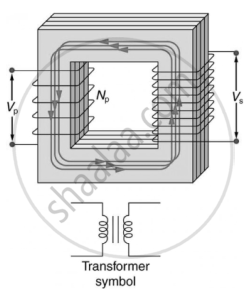Advertisements
Advertisements
Question
The primary coil having NP turns of an ideal transformer is supplied with an alternating voltage VP. Obtain an expression for the voltage VS induced in its secondary coil having NS turns.
Solution

For the simple transformer shown in the figure, the output voltage VS depends almost entirely on the input voltage VP and the ratio of the number of loops in the primary and secondary coils. Faraday's law of induction for the secondary coil gives its induced output voltage VS to be
`V_S = -N_S((Deltaphi)/(Deltat))` .....(i)
Where NS is the number of loops in the secondary coil and `(Deltaphi)/(Deltat)` is the rate of change of magnetic flux.
The cross-section area of the coils is the same on either side, as is the magnetic field strength, and so `(Deltaphi)/(Deltat)` is the same on either side. The input primary voltage VP is also related to changing flux by
`V_P = -N_P(Deltaphi)/(Deltat)` .....(ii)
Lenz's law tells us that the primary coil opposes the change in flux caused by the input voltage VP hence the minus sign is given.
Dividing both the equation, we get
`V_S/V_P = N_S/N_P`
`V_S = V_P(N_S/N_P)`
APPEARS IN
RELATED QUESTIONS
State the principle of the step-down transformer and its working.
What type of current is transmitted from the power station?
How are the e.m.f in the primary and secondary coils of a transformer related with the number of turns in these coils?
Describe, with the help of a suitable diagram, the working principle of a step-up transformer. Obtain the relation between input and output voltages in terms of the number of turns of primary and secondary windings and the currents in the input and output circuits.
Transformer works on ______.
State whether true or false. If false, correct the statement.
A transformer can step up direct current.
The output power in step-up transformer used in practice is ______.
A transformer is essentially an a.c. device. It cannot work on d.c. It changes alternating voltages or currents. It does not affect the frequency of a.c. It is based on the phenomenon of mutual induction. A transformer essentially consists of two coils of insulated copper wire having different numbers of turns and wound on the same soft iron core.
The number of turns in the primary and secondary coils of an ideal transformer is 2000 and 50 respectively. The primary coil is connected to a main supply of 120 V and secondary coil is connected to a bulb of resistance 0.6 Ω.
Power in primary coil is ______.
1 MW power is to be delivered from a power station to a town 10 km away. One uses a pair of Cu wires of radius 0.5 cm for this purpose. Calculate the fraction of ohmic losses to power transmitted if
- power is transmitted at 220 V. Comment on the feasibility of doing this.
- a step-up transformer is used to boost the voltage to 11000 V, power transmitted, then a step-down transfomer is used to bring voltage to 220 V. (ρCu = 1.7 × 10–8 SI unit)
